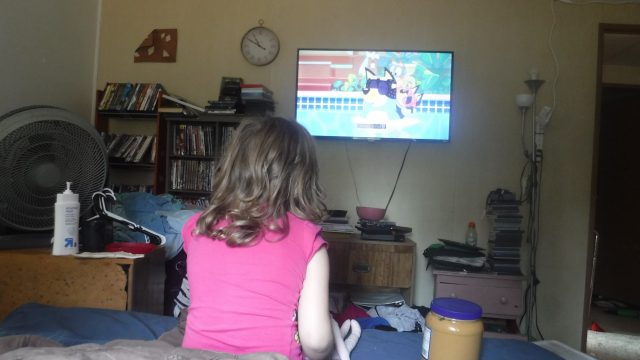This show was actually suggested to me some time ago, and it felt like time. For one thing, I don’t want to give the impression that all children’s programming is terrible. Or even that my kids have universally terrible taste. (Zane actually has pretty impeccable taste in clothes, but it doesn’t come up much in these articles.) It’s just that we had a living room TV until it gave out the other day, and I wasn’t as in touch with what they were watching for a while, because it wasn’t in my room. I didn’t have to be familiar with every second of plot, which makes for less compelling articles.
Bluey (not credited) is a six-year-old Blue Heeler puppy. She has a four-year-old sister, Bingo (also not credited), who is a Red Heeler. Their parents are Bandit (David McCormick), an archaeologist, and Chilli (Melanie Zanetti), who works part-time in airport security. Bandit spends a lot of time taking care of the kids. There are assorted other families of dogs that they know and play with, doing assorted Australian things. There is genuine conflict, albeit low stakes, that is often resolved by stopping and thinking for two minutes altogether.
The puppies are all voiced by children of the production staff. They are uncredited because they are being given their privacy, as far as I can tell. What I will note, though, is that I didn’t realize that Bluey was intended to be a girl. In fact, I was being annoyed that all the male puppies were designed to look like their fathers and all the female ones were designed to look like their mothers. But Bluey looks like Bandit. That said, I asked Sandy, and she told me that both the puppies sound like girls, but that Bluey is a boy. We did watch an episode together where Bandit referred to them as “you girls,” but I think it’s her assumption that shows are mostly about boys unless the show goes out of its way to tell you it’s about girls.
Frankly, though, my favourite character is Bandit. Chilli isn’t the focus much; the kids spend most of their time with Bandit. The kids play vast numbers of imaginary games—the inner life of children is vivid and complicated—and they often involve their dad in them. He is the patient when they play hospital. He is the guest when they play hotel. At one point, for reasons, they make him and one of the other daddy dogs pretend to be horsies getting married. The best part is that Bandit is all-in on this and pretends to be hurt when the other dad doesn’t want to marry him.
The show gives Bingo room to develop, too. She wants to do everything Bluey does and wants to have the same friends and so forth. There’s a whole episode where she has to process that she’s just not up for the same level of roughhousing that Bluey is. Chilli teaches Bingo to use her “big-girl bark” to express her boundaries. I’m not fond of Bandit’s “you need to learn to do it all yourself” attitude and think he could be more supportive of Bandit, but it’s nice to know that Chilli has her back when it’s necessary. Her constant name changes also probably resonate with Sandy, who is her age and spends her days as Dora the Explorer, Coraline, and Kim Possible.
The one that probably connects with my eight-year-old, despite his being two years older, is that Bluey’s biggest problem come from her conviction that she should be in charge of everything and that everyone should do as she says. That’s the problem with roughly a third of the episodes. Bluey has to learn, again, that people don’t have to do what she wants them to. In Bluey’s case, this doesn’t come across as “no one ever says no to that kid,” the way it does in a lot of shows I loathe, but as “this is a problem Bluey is going to take time to work on.” This is because people do push back, and Bluey is acting like a normal child her age.
The parents have different techniques. The children have personalities. The parents have relationship issues while still loving one another. The animation is actually good, and if I still do have problems with how the puppies are pretty much universally just smaller, less detailed versions of a parent’s design, the show does have a lovely style. We learn about all sorts of the characters—Indy’s mom won’t let her have wheat, sugar, dairy, or gluten. The children live in the sort of real world that real children live in; no wonder my kids like the show.
Help us replace the burnt-out TV; consider supporting my Patreon or Ko-fi!


